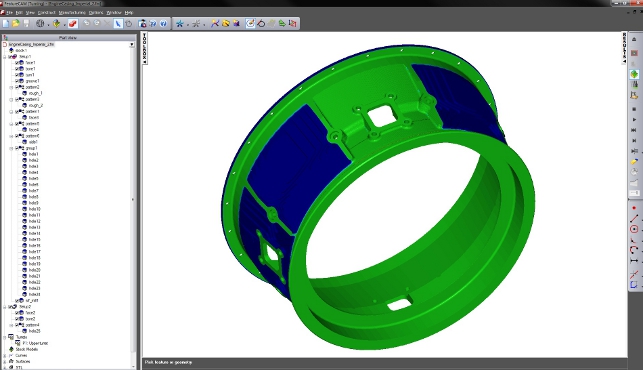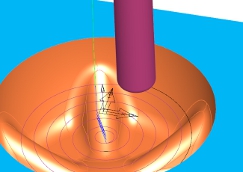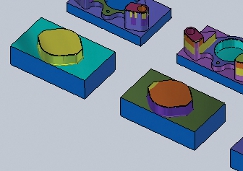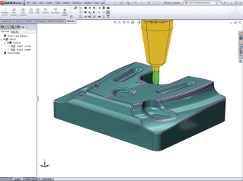FeatureCAM has come on a great deal since Delcam acquired it.
It still addresses the production machining end of the market where geometry may not be as complex as found in Delcam’s traditional Mould and Die market, but where a different set of challenges are at play.

Comparison between the machined part and the CAD model has been extended to four and five-axis machining, and mill-turn operations
Here, programming time is paramount but the time considerations are perhaps slightly different. It may be the case that a one off or small batch is required, so the part needs to be programmed and machined quickly.
Conversely, it may be that a simple part is needed in high volumes, in which case more time needs to be taken to get the cycle time down. It’s because of this mix of priorities that Delcam has brought much more to the table.
For complex tasks, the process of integrating all of its knowledge and experience from PowerMill means that FeatureCAM is now more capable when handling complex parts. This is tempered with the need to get the NC code done, dusted and in use as quickly as possible.
For FeatureCAM 2012, Delcam claims that the operation and machining strategies between PowerMill and FeatureCAM are now comparable.
The key difference is that with PowerMill users can continue to dive in and tweak each option and each parameter to match their requirements. Instead of introducing such tools to FeatureCAM, the goal has been to make it easier to use, especially for the casual user.
A good example is how workflow has been enhanced with the use of hotkeys to expose more functions. This makes the whole system more efficient, particularly when working with large and complex datasets.
It has also been made more accessible for the casual user. For example, features and operations can now be multi-selected using the standard Windows keyboard modifiers and it also works with standard cut/copy/paste keys.
More flexible operations
There are new technical updates intended to take the pain out of the NC programming process. Step-overs and step-downs are now more flexible.
In previous releases, these two key values would be driven purely by the material (such as 10% step-over for aluminium), but this can now be adapted to a percentage of the cutter length as well and by operation type.
Another area is back boring or trepanning. This typically requires a part to be re-fixtured, but many machinists avoid this by using the combination of a controller specific operation (such as a G87 on a Fanuc control) and an I-shaped cutter.
Using the tools within FeatureCAM, the process of inserting the cutter into a hole, positioning it, cutting the required feature and then retracting it, can all be done in a single operation.
In terms of machining operation updates, enhancements have been made to spiral roughing on 3D surface models.
Whereas previous releases used a concentric circular path with link, the system now uses the same method as PowerMill and creates these tool-paths using a helix into the material. This constant tool loading means less stress on the cutter and machine tool.
Turning & TurnMill features
There are some pretty specific turning updates.
One is the added support for a machining stock. With a G71 move, it’s not possible to zero out a part as a finishing pass as an over stock for the finishing pass needs to be left.
With FeatureCAM 2012 it is now possible to do this without having to offset the driving curves.
Interestingly, if this move is given a minus value, material can be shaved off a part below the defined geometry.
This may sound counterintuitive, but if a user is trying to solve fit issues or needs to include a sparking allowance when cutting an electrode, it could come in handy.
A big bonus is that this is all done by playing with numerical input, rather than having to edit the underlying geometry.
The other major turning related update is the ability to load solid models of cutters (from suppliers such as Sandvik), which can be used for collision avoidance calculation.
This will pay the most dividends when working with complex multi-turret mill-turn machines where space is very tight.
Part comparison
Another big update for FeatureCAM is the ability to compare the machined part against the originating CAD geometry for multi-axis operation as well as for simpler two and three-axis equipment.
These tools enable the user to simulate the shape after each operation or the final shape using the complete list of operations. It displays the material on the part using a colour code, green being in tolerance through to dark blue. If red shows up, there’s been an over-cut.
Conclusion
Delcam has a vast array of knowledge in the world of machining and it’s been expanding outside its historical core competence for many years now.
Looking at the company’s portfolio, there’s PowerMill at the high-end, then there’s PartMaker for Swiss-lathes and then FeatureCAM for feature-based machining and turning.
The company is taking the knowledge and experience from each of these very different systems and cross fertilising its products, so that each gains from the others, but in the context that’s most suitable to its user community and target audience.
FeatureCAM is now moving beyond its traditional working area and getting some seriously complex tools from both PowerMill and PartMaker – but in a manner that’s easy to use and deploy in any organisation.
Alongside this, the introduction of Delcam for SolidWorks brings this vast array of knowledge and capability into the CAD integrated world.
So whether you’re looking for a standalone CAM system that can handle almost everything, from the mundane to the highly complex, or a CAD integrated system that works directly with your native data, Delcam has a solution for you.
Delcam for SolidWorks
Delcam for SolidWorks (DFS) sees the FeatureCAM tools integrated directly in one of the leading mainstream applications.
Usability: As with all SolidWorks integrated applications, much of the functionality is provided through the PropertyManager to the left hand side of the UI.
The 2012 release sees a new tab added here which gives users direct access to rolling video demos and other learning support.
Multiple fixture set-up: A big update for this release is the ability to create multiple set-ups in a single file.
Using the SolidWorks assembly functionality, full fixturing rigs can be defined, then used during the NC programming process and for clash and collision detection.
It’s useful for both complex parts as well as scenarios where the user may need to program machining of multiple components on a single bed or on tombstones.
Stock Model updates: Stock models, referring to the use of persistent models representing the already machined model, have been in DFS since release, but haven’t been taken advantage of as yet.
The system currently cuts each pass without taking into consideration the results of the previous operation, however this changes for the 2012 release.
While it’s not automated, it’s a relatively trivial task to load for each operation and have the system use the stock model to ensure no fresh air cuts are made.
Wiring: This release sees the introduction of a Wire EDM module into DFS.
While it’s not quite up to speed with the functionality found in FeatureCAM, it supports two-axis cutting, but as yet, no 4-axis operations.
This is scheduled for early 2012.
| Product | FeatureCAM and Delcam For SolidWorks |
|---|---|
| Company name | Delcam |
| Price | on application |










